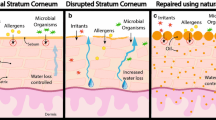Summary
The effects of different pharmacological substances on dithranol-induced irritative dermatitis were studied in mice. Pretreatment of the animals with a specific platelet activating factor (PAF) antagonist, BN 52021, significantly reduced the ear swelling in a dose-dependent manner. The cyclooxygenase inhibitor indomethacin, the antihistamine clemastine, and the antioxidant superoxide dismutase also proved to be effective in the reduction of the dermatitis.
The results provide evidence of the coinvolvement of PAF, prostaglandins, histamine, and reactive oxygen radicals in dithranol-induced irritative dermatitis in mice.
Similar content being viewed by others
References
Archer CB, Page CP, Morley J, MacDonald DM (1985) Accumulation of inflammatory cells in response to intracutaneous platelet activating factor (Paf-acether) in man. Br J Dermatol 112:285–290
Au AM, Chan PM, Fishman RA (1985) Stimulation of phospholipase A2 activity by oxygen-derived free radicals in isolated brain capillaries. J Cell Biochem 27:449–453
Barnes PJ, Chung KF, Page CP (1988) Platelet activating factor as a mediator of allergic disease (review). J Allergy Clin Immunol 81:919–934
Benveniste J, Chignard M, Le Couedic JP, Vargaftig BB (1982) Biosynthesis of platelet-activating factor (PAF-acether). II. Involvement of phospholipase A2 in the formation of PAF-acether and lyso-PAF-acether from rabbit platelets. Thromb Res 25:375–385
Braquet P, Touqui L, Shen TY, Vargaftig BB (1987) Perspectives in platelet activating factor research. Pharmacol Rev 39:97–145
Calignano A, Cirino G, Meli R, Persico P (1988) Isolation and identification of platelet activating factor in UV-irradiated guinea-pig skin. J Pharmacol Methods 19:89–91
Csató M, Czarnetzki BM (1988) Effect of BN 52021, a platelet activating factor antagonist, on experimental murine contact dermatitis. Br J Dermatol 118:475–480
Csató M, Rosenbach T, Möller A, Czarnetzki BM (1987) Generation of platelet aggregating activity from murine epidermal cells. J Invest Dermatol 89:440 (abstract)
Finnen MJ, Lawrence CM, Shuster S (1984) Inhibition of dithranol inflammation by free radical scavengers. Lancet 2:1129–1130
Januszkiewicz AJ, Huntrakoon M, Wilson PK, Faiman MD (1986) Isolated perfused lung histamine release, lipid peroxidation and tissue superoxide dismutase from rats exposed to normobaric hyperoxia. Toxicology 39:37–46
Kemény L, Csató M, Nyirádi J, Gábor M, Dobozy A (1989) Untersuchung der irritativen Wirkung des Dithranols mittels Kapillarresistenzmessung. Z Hautkr 64:34–40
Kingston T, Marks R (1983) Irritant reaction to dithranol in normal subjects and psoriatic patients. Br J Dermatol 108:307–313
Lawrence CM, Shuster S (1985) Mechanism of anthralin inflammation. I. Dissociation of response to clobetasol and indomethacin. Br J Dermatol 113:107–115
Martinmaa J, Juselius J, Mustakallio KK (1981) Free radicals by auto-oxidation of anthralin and its 10-acyl analogues. Br J Dermatol 20 [Suppl]:52
McCord JM, Fridovich I (1969) Superoxide dismutase: an enzymic function for erythrocuprein (hemocuprein). J Biol Chem 244:6049–6055
Mish K, Davies M, Greaves MW, Coutts A (1981) Pharmacological studies of anthralin erythema. Br J Dermatol 20 [Suppl]:82–86
Ohmori H, Yamamoto I, Akagi M, Tasaka K (1980) Properties of hydrogen-peroxide-induced histamine release from rat mast cells. Biochem Pharmacol 28:741–745
Shroot B, Brown C (1986) Free radicals in skin exposed to dithranol and its derivates. Arneimittelforsch 36:1253–1255
Warso MA, Lands WEM (1983) Lipid peroxidation in relation to prostacyclin and thromboxane physiology and pathophysiology. Br Med Bull 39:277–280
Author information
Authors and Affiliations
Rights and permissions
About this article
Cite this article
Kemény, L., Csató, M. & Dobozy, A. Pharmacological studies on dithranol-induced irritative dermatitis in mice. Arch Dermatol Res 281, 362–365 (1989). https://doi.org/10.1007/BF00412983
Received:
Issue Date:
DOI: https://doi.org/10.1007/BF00412983




